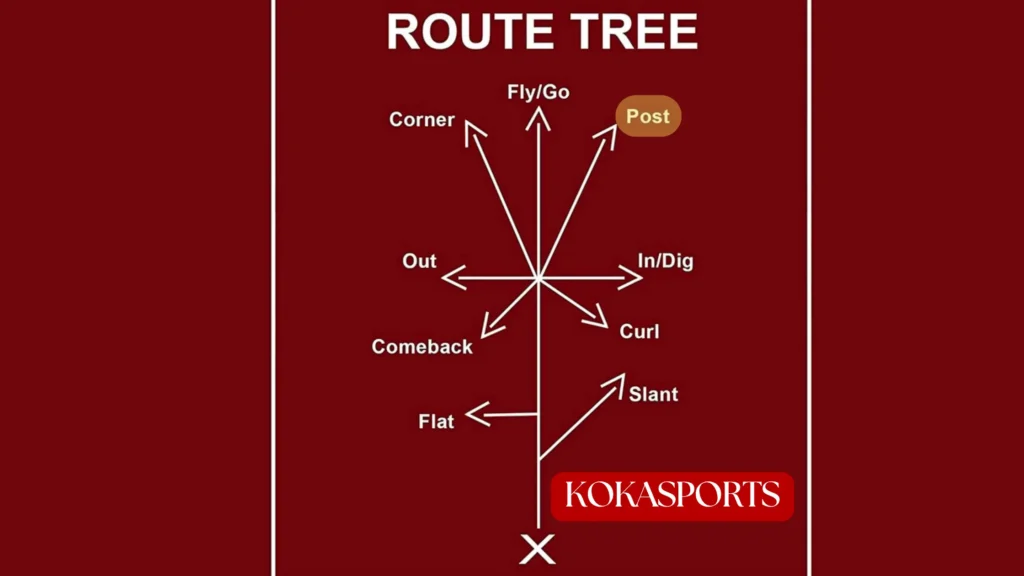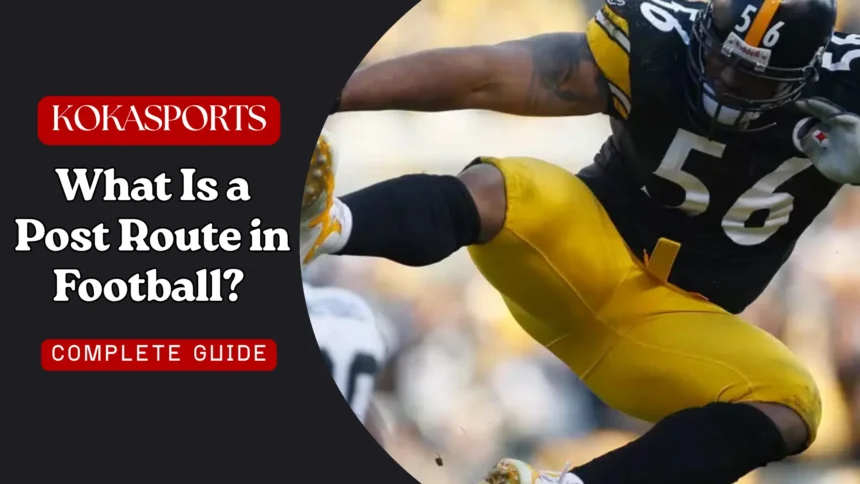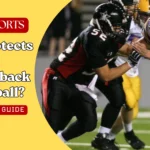In American football, mastering the art of route running separates good receivers from great ones. Among all the different routes a receiver can run, few are as explosive or strategically valuable as the post route in football. This deep passing route has been a cornerstone of offensive playbooks for decades, creating big-play opportunities and stretching defenses vertically.
Whether you’re a player looking to improve your skills, a coach designing plays, or a fan wanting to better comprehend the pass game, grasping how routes work—especially the post route—will deepen your appreciation of football strategy. The football route tree serves as the foundation for organizing these passing routes, giving quarterbacks and receivers a shared language to execute plays with precision.
In this guide, we’ll break down everything about the post route, compare it to other routes like the corner route, slant, and skinny post, and show you how it fits into the broader offensive scheme.
What Is a Route in Football?

A route in football represents the specific path a receiver takes after the ball is snapped. The primary goal of any route is to create separation from the defender, giving the quarterback a clear throwing window. Success depends on several factors: timing between the quarterback and receiver, precise footwork, speed, and reading defensive coverage.
When a receiver runs the route correctly, they’re not just following a predetermined path—they’re reacting to how defenders position themselves, adjusting their speed and angle to maximize separation. This chess match between receiver and defender happens on nearly every pass play, making route running one of the most technical skills in football.
The connection between routes and passing plays is simple: without well-executed routes, even the best quarterback cannot deliver accurate passes. Receivers must reach specific spots on the field at exact moments, allowing the quarterback to throw with anticipation rather than reaction.
Read More: What Is a Dig Route in Football? Complete Guide to the Route Tree & Receiver Routes
The Football Route Tree Explained
The route tree is a numbering system that categorizes every route in the offensive playbook. This system, used by the best football coaches across all levels, assigns numbers 0-9 to different routes based on their direction and depth. Here’s how the basic route tree breaks down:
| Route Number | Route Name | Direction |
|---|---|---|
| 0 | Hitch Route | Quick stop, minimal depth |
| 1 | Flat Route | Toward sideline, shallow |
| 2 | Slant Route | Diagonal toward middle |
| 3 | Comeback Route | Deep then back to sideline |
| 4 | Curl Route | Deep then curl back |
| 5 | Dig Route | Across field horizontally |
| 6 | Dig Route | Across middle at depth |
| 7 | Corner Route | Deep toward corner of the end zone |
| 8 | Post Route | Deep toward goal post |
| 9 | Go Route/Fade Route | Straight down the field |
The route tree is a numbering system that helps offensive coordinators call plays efficiently. Instead of describing each route verbally, they can simply say “run an 8-route” and every receiver knows exactly what path to take. This standardization has become universal across football programs, from youth leagues to the NFL.
The basics of the route tree divide routes into three categories: short routes (0-3 yards), intermediate routes (4-12 yards), and deep routes (15+ yards). The post route falls into the deep category, making it one of the most dangerous weapons in any offensive arsenal.
What Is a Post Route in Football?

The post route gets its name from its defining characteristic: the receiver breaks toward the goal post at the center of the end zone. This route typically starts with the receiver running straight down the field for 8-12 yards, then making a sharp cut at roughly a 45-degree angle toward the middle of the field.
Why the Post Route Works
The route is designed to attack the deep middle of the field, exploiting the space between safeties or behind linebackers. When defensive backs play outside leverage (protecting the sideline), the post route allows receivers to break inside and gain a step toward open territory. This angle toward the center of the field forces defenders to flip their hips and chase, often arriving too late to make a play.
The post is a deep route that requires exceptional timing. The quarterback must release the ball before the receiver makes their final cut, trusting that the receiver will be at the right spot when the ball arrives. This anticipation throws make the post route both thrilling and challenging to execute.
How to Execute a Post Route
For wide receivers learning to run the route, technique is everything:
- Release from the line of scrimmage: Beat any press coverage with quick footwork and hand usage
- Run straight down the field: Build vertical speed to threaten defenders deep
- Set up the cut: At 8-12 yards down the field, plant the outside foot hard
- Break toward the goal post: Make a sharp 45-degree cut inside
- Track the ball: Look back for the pass while maintaining speed
- Adjust to coverage: Read the safety and find the throwing window
The key to a great route is selling the vertical threat before breaking inside. If a receiver telegraphs the cut too early, defenders will jump the route. The element of surprise, combined with speed, makes the post route effective against defenses at all levels.
Post Route vs Corner Route: Key Differences
While both are deep routes originating from similar stem, the post route and corner route break in opposite directions. The corner route breaks toward the sideline and corner of the end zone, while the post route breaks toward the goal post and middle of the field.
When to Use Each Route:
- Post Route: Best against single-high safety looks or when safeties shade outside
- Corner Route: Ideal versus two-deep coverage when safeties sit in the middle
The post-corner route combines both concepts. A receiver runs what appears to be a post route, getting the safety to bite toward the middle, then breaks back outside to the corner. This double move can create wide-open touchdowns when executed properly.
Variations of the Post Route
The Skinny Post Route
The skinny post is a variation that features a sharper angle and quicker break than the traditional post route. Instead of the standard 45-degree cut, the skinny post route uses a steeper angle, approximately 60-70 degrees toward the middle of the field.
This route is usually run from the slot position and proves especially effective against Cover 2 defenses, where two safeties divide the deep field. The skinny post attacks the seam between the corner and safety, finding space in an otherwise crowded secondary. Fast receivers with precise footwork excel at this route because it demands quick acceleration out of the break.
Seam Route Comparison
The seam route differs from the post route in one crucial way: it goes straight up the field rather than breaking at an angle. Tight ends and slot receivers often run seam routes, threatening the vertical middle while the outside receiver runs a post route. This combination stresses defenses by attacking multiple levels of the middle of the field simultaneously, making it a top route combination in modern offenses.
Comparing the Post Route to Other Common Routes

Post Route vs Slant Route
The slant is a quick, short route where the receiver breaks inside immediately after the line of scrimmage, typically at 3-5 yards. Both routes attack the middle of the field, but the slant targets the shallow area while the post route stretches defenses deep. The slant route serves as a quick-hitting option against aggressive press coverage, while the post route is used for big-play opportunities down the field.
Post Route vs Go Route
Both routes require receivers to run straight down the field initially, threatening defenders vertically. The difference appears at the top of the route: on a go route (or fade route), the receiver continues straight, trying to outrun the defender. On a post route, the receiver breaks inside toward the goal post, creating separation through the cut rather than pure speed. Many receivers will run a go route on the outside while another receiver runs a post route, giving the quarterback multiple deep options.
Post Route vs Dig Route
The dig route (also called a square-in) is an intermediate route where the receiver drives 10-12 yards downfield, then breaks horizontally across the field. The dig route is often used on third down to move the chains, while the post route aims for explosive gains. Both routes involve breaking toward the middle of the field, but at vastly different depths and angles.
Other Essential Routes in the Route Tree
Flat Route: A shallow, quick out-breaking route toward the sideline, usually run by running backs or tight ends
Hitch Route: The receiver stops and comes back to the quarterback after a few yards down the field
Comeback Route: Deep route where the receiver drives 12-15 yards, then breaks back toward the sideline
Whip Route: An option route where the receiver reads the defender and breaks inside or outside
Drag Route: A shallow crossing route where the receiver runs laterally across the formation
Option Route: The receiver will run different patterns based on defensive coverage, requiring chemistry with the quarterback
Each of these routes serves a specific purpose, and understanding how they complement each other helps illustrate why the post route is one of the most valuable tools in offensive football.
Strategic Use of the Post Route
The route is effective against defenses that use single-high safety alignments (Cover 1 or Cover 3). With only one safety protecting the deep middle of the field, the post route forces that safety to make a choice: take away the post or protect against the go route on the outside. Either choice creates an opportunity for the offense.
Best Situations for the Post Route:
- Play-action passes that freeze linebackers and safeties
- When defenders give cushion at the line of scrimmage
- Against man coverage with inside leverage
- When the safety shows pre-snap they’re responsible for the deep outside
The route is similar to the go route in how it stretches the defense vertically, but the inside break adds a horizontal element that makes it harder to defend. Defensive coordinators must account for the post route when designing coverage schemes, often dedicating specific defenders to take away this explosive option.
Tips for Mastering the Post Route
For Receivers:
- Acceleration matters more than top speed: Exploding out of the break creates separation
- Use head fakes: Look to the outside before cutting inside to manipulate defender leverage
- Track the ball over the correct shoulder: Anticipate where the quarterback will place the throw
- Maintain speed through the cut: Slowing down telegraphs the break
For Quarterbacks:
- Throw to a spot, not the receiver: Anticipate where the receiver will be, not where they are
- Read the safety pre-snap: Identify single-high versus two-high looks
- Release the ball before the receiver breaks: Timing is everything on deep routes
- Put air under the throw: Give the receiver space to run under the ball
Practice Drills:
- Stem and cut drill: Focus solely on the plant foot and hip turn at the break point
- Ball tracking drill: Coach throws deep passes while receiver practices looking back
- 1-on-1 coverage: Receiver versus defender working on selling the vertical threat
- Timing routes with quarterback: Build chemistry on when to release the throw
Famous Post Route Moments
Throughout NFL history, the post route has produced countless memorable plays. Jerry Rice, widely considered the greatest receiver ever, built much of his success on precise route running including devastating post routes that left defenders helpless. Randy Moss used his combination of speed and size to dominate on deep post patterns, often catching the ball at the highest point over smaller defenders.
In modern football, players like Tyreek Hill have made the skinny post their signature weapon, using blazing speed to separate from defenders and score from anywhere on the field. The route remains a staple because it works: when executed correctly, it’s nearly impossible to defend.
Conclusion
The post route represents one of the most effective weapons in football, combining speed, precision, and strategy into a single explosive play. As part of the route tree, it serves as a deep passing route that attacks the vulnerable area of the field between safeties and over linebackers.
From the basics of the route tree to advanced concepts like the skinny post and post-corner routes, mastering this route opens up entire playbooks for offenses. Whether you’re studying how to run the route as a receiver, timing it as a quarterback, or simply appreciating the strategy as a fan, the post route showcases the beautiful complexity of football.
Every route serves a purpose, but few create the explosive plays and strategic dilemmas that the post route delivers. By forcing defenders to respect the deep threat and make split-second decisions, this basic route has remained a cornerstone of offensive football for generations—and it shows no signs of disappearing anytime soon.
FAQs
What’s the difference between a post route and a dig route?
A post route breaks toward the goal post; a dig route cuts straight across the field.
What does “post” mean in football?
It refers to the goal post receivers run their break toward it.
What is a post pattern?
It’s another name for a post route, cutting toward the middle and goal post.
What is a football flag route?
A flag (or corner) route breaks toward the sideline, away from the goal post.




